NB-IoT: how does it work? Part 2
Last time we talked about the features of the new standard NB-IoT in terms of the radio access network architecture. Today, we reflect on what has changed in the core network (Core Network) with NB-IoT. So let's go.

There have been significant changes in the network core. Let's start with the fact that a new element has appeared, as well as a number of mechanisms that are defined by the standard as “CIoT EPS Optimization” or optimization of the core network for the cellular Internet of things.
As you know, in mobile networks there are two main communication channels called Control Plane (CP) and User Plane (UP). Control Plane is designed for exchanging service messages between various network elements and serves to provide mobility (Mobility management) of devices (UE) and establish / maintain a data transfer session (Session Management). User Plane is, in fact, the transmission channel of user traffic. In classic LTE, the distribution of CP and UP across interfaces is as follows:

The CP and UP optimization mechanisms for NB-IoT are implemented on MME, SGW and PGW nodes, which are conventionally combined into a single element called C-SGN (Cellular IoT Serving Gateway Node). The standard also assumes the appearance of a new network element - SCEF (Service Capability Exposure Function). The interface between MME and SCEF is called T6a and is based on the DIAMETER protocol. Although DIAMETER is a signaling protocol, in NB-IoT it is adapted to transmit small amounts of non-IP data.
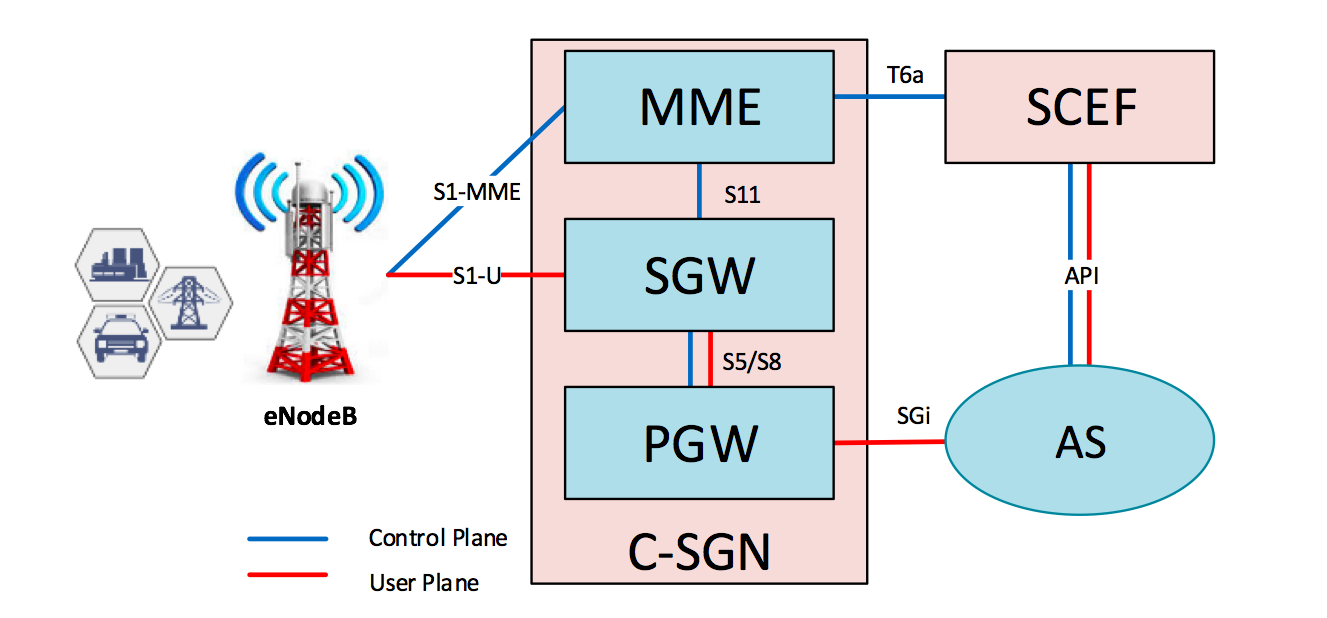
Based on the name, SCEF is a site for exhibiting service capabilities. In other words, SCEF hides the complexity of the operator’s network, and also removes the need for identification and authentication of mobile devices (UE) from application developers, allowing the application servers (Application Server, further AS) to receive data and manage devices through a single API interface.
The UE identifier is not a phone number (MSISDN) or an IP address, as was the case with the classic 2G / 3G / LTE network, but the so-called “external ID”, which is defined by the standard in the format familiar to application developers “<Local Identifier> @ <Domain Identifier> ". This is a separate big topic that deserves a separate material, therefore we will not discuss this in detail now.
Now let's look at the most significant innovations. CIoT EPS Optimization is the optimization of the traffic transmission and subscriber session management mechanisms. Here are the main ones:
DoNAS (Data over NAS):
This is a mechanism designed to optimize the transfer of small amounts of data.
In classic LTE, the subscriber device establishes a PDN connection (hereinafter PDN) through the eNodeB to the MME-SGW-PGW when registering on the network. The UE-eNodeB-MME connection is the so-called “Signaling Radio Bearer” (SRB). If it is necessary to transmit / receive data, the UE establishes one more connection to the eNodeB - “Data Radio Bearer” (DRB), to transfer user traffic to SGW and then to PGW (interfaces S1-U and S5, respectively). At the end of the exchange and if there is no traffic for some time (usually 5-20 seconds), these connections are broken and the device goes into standby mode or “Idle Mode”. If it is necessary to exchange a new portion of data, SRB and DRB are reset.
In NB-IoT, user traffic can be transmitted through the signaling channel (SRB), in NAS protocol messages ( http://www.3gpp.org/more/96-nas ). Establishing a DRB is no longer required. This significantly reduces the signal load, saves the radio resources of the network and, most importantly, extends the life of the device's battery.
In the eNodeB - MME section, user data begins to be transmitted via the S1-MME interface, which was not the case with the classic LTE technology, and the NAS protocol is used for this, in which “User data container” appears.
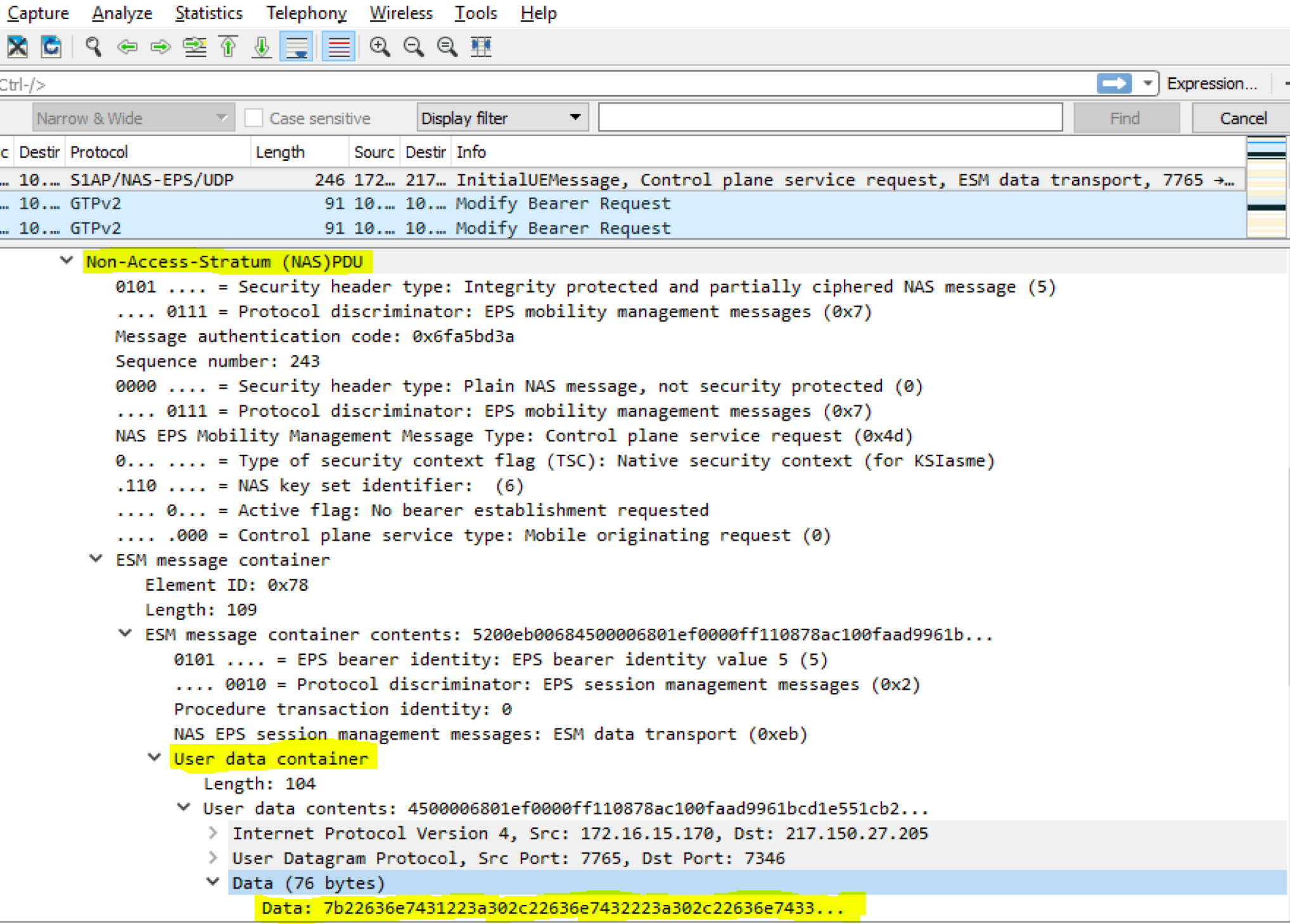
To implement the transfer of “User Plane” from MME to SGW, a new interface S11-U appears, which is designed to transmit small amounts of user data. The S11-U protocol is based on GTP-U v1, which is used to transmit User Plane and other interfaces of the 3GPP architecture network.
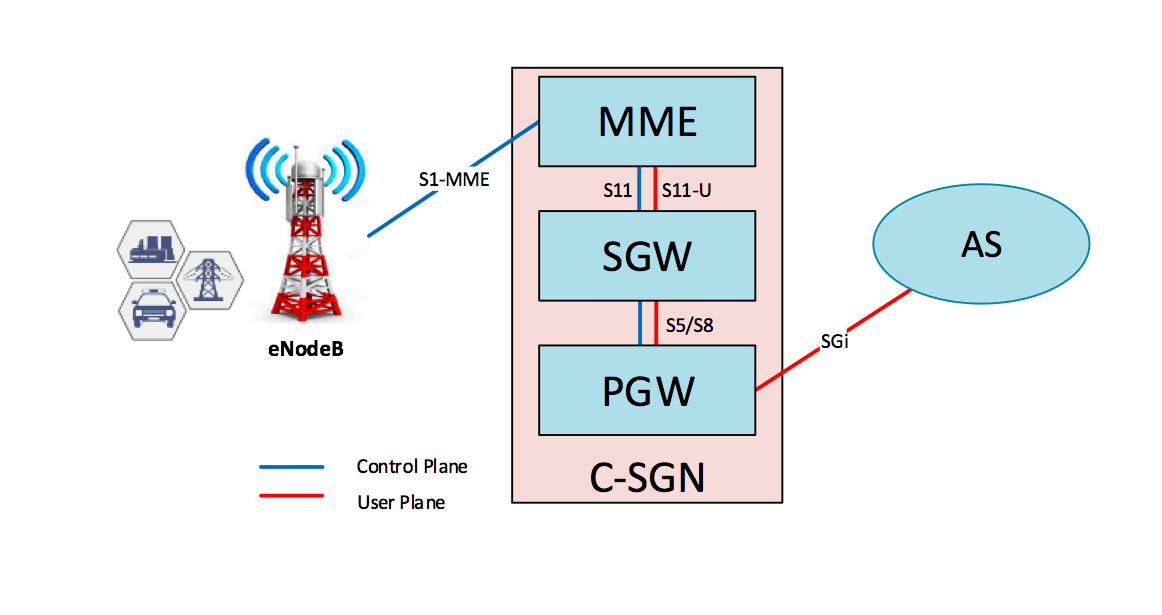
NIDD (non-IP data delivery):
As part of the further optimization of the mechanisms for transferring small amounts of data, in addition to the existing PDN types, such as IPv4, IPv6 and IPv4v6, another type has emerged - non-IP. In this case, the UE is not assigned an IP address, and the data is transmitted without using the IP protocol. There are several reasons for this:
By and large, the IP address is necessary for IoT devices to transmit data over the Internet. In the NB-IoT concept, SCEF acts as a single point of connection AS, and data is exchanged between devices and application servers via an API. In the absence of SCEF non-IP, data can be transmitted to the AS via Point-to-Point (PtP) tunnel from PGW and encapsulation in IP will be made already on it.
All this fits into the NB-IoT paradigm - the maximum simplification and cheapening of devices.
Energy saving mechanisms PSM and eDRX:
One of the key advantages of LPWAN networks is energy efficiency. Declared up to 10 years of autonomous operation of the device on a single battery. Let us see how such values are achieved.
When does the device consume the least energy? That's right, when it's off. And if it is impossible to completely de-energize the device, let's de-energize the radio module for the time it is not necessary. Only it is necessary to coordinate it with the network.
PSM (Power saving mode):
The PSM power saving mode allows the device to permanently turn off the radio module while remaining registered to the network and not to reinstall the PDN every time it is necessary to transfer data.
In order for the network to know that the device is still available, it periodically initiates the update procedure - Tracking Area Update (TAU). The frequency of this procedure is set by the network using the timer T3412, the value of which is transmitted to the device during the Attach procedure or the next TAU. In classic LTE, the default value of this timer is 54 minutes, and the maximum is 186 minutes. However, to ensure high energy efficiency, the need to go on the air every 186 minutes is too expensive. To solve this problem, the PSM mechanism was developed.
The device activates the PSM mode by transmitting in the “Attach Request” or “Tracking Area Request” messages the values of the two timers T3324 and T3412-Extended. The first determines the time that the device will be available after the transition to "Idle Mode". The second is the time after which TAU should be produced, only now its value can reach 35712000 seconds or 413 days. Depending on the settings, the MME may accept the timer values received from the device, or modify them by sending new values in the “Attach Accept” or “Tracking Area Update Accept” messages. Now the device may not turn on the radio module for 413 days and remain registered with the network. As a result, we get a tremendous saving of network resources and energy efficiency of devices!
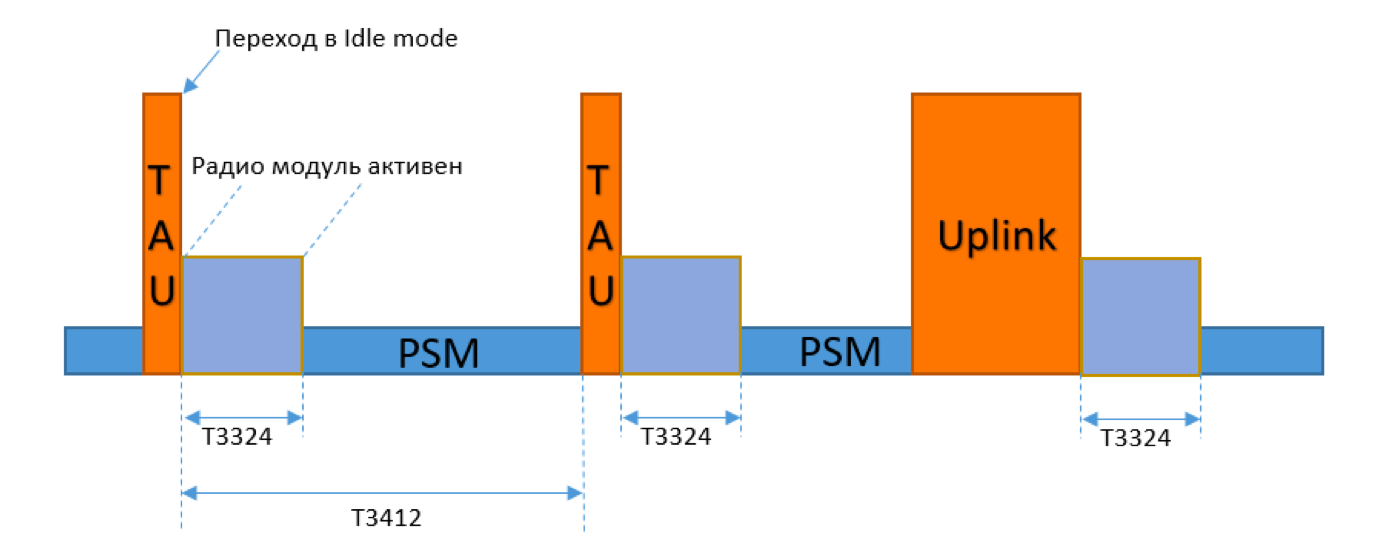
However, in this mode, the device is not available only for incoming communications. If it is necessary to transfer something towards the application server, the device can exit the PSM at any time and send data, remaining active during the T3324 timer for receiving informational messages from the AS (if any).
eDRX (extended discontinuous reception):
eDRX, extended discontinuous reception mode. To transfer data to a device that is in “Idle mode”, the network performs the notification procedure - “Paging”. When receiving a paging device initiates the establishment of SRB for further communication with the network. But in order not to miss the Paging message addressed to him, the device must constantly monitor the airwaves, which is also quite energy-intensive.
eDRX is a mode in which the device receives messages from the network not all the time, but periodically. During the Attach or TAU procedures, the device coordinates with the network the time intervals during which it will “listen” to the broadcast. Accordingly, the Paging procedure will be performed at the same intervals. In eDRX mode, the device operation is divided into cycles (eDRX cycle). At the beginning of each cycle, there is a so-called “paging window” (Paging Time Window, hereinafter PTW) - this is the time that the device listens to the radio channel. At the end of the PTW, the device turns off the radio module until the end of the cycle.
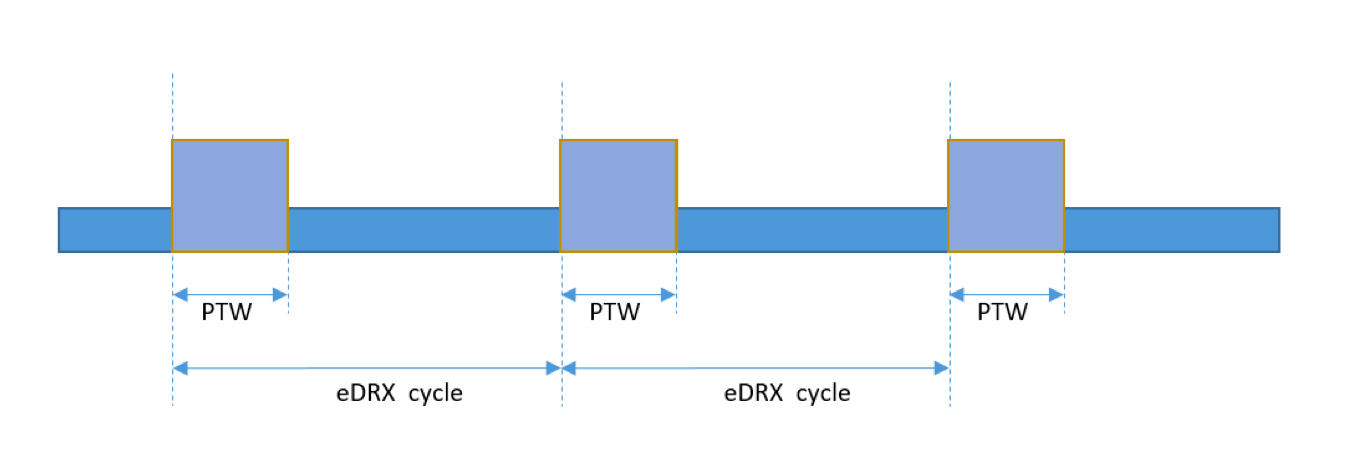
HLCOM (high latency communication):
If it is necessary to transfer data to the Uplink, the device can exit any of these two power saving modes without waiting for the PSM or eDRX cycle to finish. But transmitting data to the device is possible only when it is active.
HLCOM functionality or high latency communication is the downlink buffering of packets on the SGW for as long as the device is in power saving mode and is not available for communication. The buffered packets will be delivered as soon as the device leaves the PSM, making a TAU or transmitting Uplink traffic, or when PTW arrives.
This, of course, requires awareness from the developers of IoT products, since communication with the device is not real-time and requires a certain approach to the design of business logic of the applications.
In conclusion, let us say: the introduction of a new one always captures, and now we are dealing with a standard that is not completely tested even by world bison, like Vodafone and Telefonica - therefore it is doubly exciting. Our presentation of the material does not pretend to be absolute, but we hope provides a sufficient understanding of the technology. We would appreciate feedback.
Author: Expert of Convergent Solutions and Multimedia Services Alexey Lapshin aslapsh

There have been significant changes in the network core. Let's start with the fact that a new element has appeared, as well as a number of mechanisms that are defined by the standard as “CIoT EPS Optimization” or optimization of the core network for the cellular Internet of things.
As you know, in mobile networks there are two main communication channels called Control Plane (CP) and User Plane (UP). Control Plane is designed for exchanging service messages between various network elements and serves to provide mobility (Mobility management) of devices (UE) and establish / maintain a data transfer session (Session Management). User Plane is, in fact, the transmission channel of user traffic. In classic LTE, the distribution of CP and UP across interfaces is as follows:

The CP and UP optimization mechanisms for NB-IoT are implemented on MME, SGW and PGW nodes, which are conventionally combined into a single element called C-SGN (Cellular IoT Serving Gateway Node). The standard also assumes the appearance of a new network element - SCEF (Service Capability Exposure Function). The interface between MME and SCEF is called T6a and is based on the DIAMETER protocol. Although DIAMETER is a signaling protocol, in NB-IoT it is adapted to transmit small amounts of non-IP data.

Based on the name, SCEF is a site for exhibiting service capabilities. In other words, SCEF hides the complexity of the operator’s network, and also removes the need for identification and authentication of mobile devices (UE) from application developers, allowing the application servers (Application Server, further AS) to receive data and manage devices through a single API interface.
The UE identifier is not a phone number (MSISDN) or an IP address, as was the case with the classic 2G / 3G / LTE network, but the so-called “external ID”, which is defined by the standard in the format familiar to application developers “<Local Identifier> @ <Domain Identifier> ". This is a separate big topic that deserves a separate material, therefore we will not discuss this in detail now.
Now let's look at the most significant innovations. CIoT EPS Optimization is the optimization of the traffic transmission and subscriber session management mechanisms. Here are the main ones:
- DoNAS
- NIDD
- PSM and eDRX power saving mechanisms
- Hlcom
DoNAS (Data over NAS):
This is a mechanism designed to optimize the transfer of small amounts of data.
In classic LTE, the subscriber device establishes a PDN connection (hereinafter PDN) through the eNodeB to the MME-SGW-PGW when registering on the network. The UE-eNodeB-MME connection is the so-called “Signaling Radio Bearer” (SRB). If it is necessary to transmit / receive data, the UE establishes one more connection to the eNodeB - “Data Radio Bearer” (DRB), to transfer user traffic to SGW and then to PGW (interfaces S1-U and S5, respectively). At the end of the exchange and if there is no traffic for some time (usually 5-20 seconds), these connections are broken and the device goes into standby mode or “Idle Mode”. If it is necessary to exchange a new portion of data, SRB and DRB are reset.
In NB-IoT, user traffic can be transmitted through the signaling channel (SRB), in NAS protocol messages ( http://www.3gpp.org/more/96-nas ). Establishing a DRB is no longer required. This significantly reduces the signal load, saves the radio resources of the network and, most importantly, extends the life of the device's battery.
In the eNodeB - MME section, user data begins to be transmitted via the S1-MME interface, which was not the case with the classic LTE technology, and the NAS protocol is used for this, in which “User data container” appears.

To implement the transfer of “User Plane” from MME to SGW, a new interface S11-U appears, which is designed to transmit small amounts of user data. The S11-U protocol is based on GTP-U v1, which is used to transmit User Plane and other interfaces of the 3GPP architecture network.

NIDD (non-IP data delivery):
As part of the further optimization of the mechanisms for transferring small amounts of data, in addition to the existing PDN types, such as IPv4, IPv6 and IPv4v6, another type has emerged - non-IP. In this case, the UE is not assigned an IP address, and the data is transmitted without using the IP protocol. There are several reasons for this:
- IoT devices, such as sensors, can transfer very small amounts of data, 20 bytes and even less. Given that the minimum size of an IP header is 20 bytes, encapsulation in IP can sometimes be quite expensive;
- There is no need to implement an IP stack in the chip, which leads to cheaper prices (a question for discussion in the comments).
By and large, the IP address is necessary for IoT devices to transmit data over the Internet. In the NB-IoT concept, SCEF acts as a single point of connection AS, and data is exchanged between devices and application servers via an API. In the absence of SCEF non-IP, data can be transmitted to the AS via Point-to-Point (PtP) tunnel from PGW and encapsulation in IP will be made already on it.
All this fits into the NB-IoT paradigm - the maximum simplification and cheapening of devices.
Energy saving mechanisms PSM and eDRX:
One of the key advantages of LPWAN networks is energy efficiency. Declared up to 10 years of autonomous operation of the device on a single battery. Let us see how such values are achieved.
When does the device consume the least energy? That's right, when it's off. And if it is impossible to completely de-energize the device, let's de-energize the radio module for the time it is not necessary. Only it is necessary to coordinate it with the network.
PSM (Power saving mode):
The PSM power saving mode allows the device to permanently turn off the radio module while remaining registered to the network and not to reinstall the PDN every time it is necessary to transfer data.
In order for the network to know that the device is still available, it periodically initiates the update procedure - Tracking Area Update (TAU). The frequency of this procedure is set by the network using the timer T3412, the value of which is transmitted to the device during the Attach procedure or the next TAU. In classic LTE, the default value of this timer is 54 minutes, and the maximum is 186 minutes. However, to ensure high energy efficiency, the need to go on the air every 186 minutes is too expensive. To solve this problem, the PSM mechanism was developed.
The device activates the PSM mode by transmitting in the “Attach Request” or “Tracking Area Request” messages the values of the two timers T3324 and T3412-Extended. The first determines the time that the device will be available after the transition to "Idle Mode". The second is the time after which TAU should be produced, only now its value can reach 35712000 seconds or 413 days. Depending on the settings, the MME may accept the timer values received from the device, or modify them by sending new values in the “Attach Accept” or “Tracking Area Update Accept” messages. Now the device may not turn on the radio module for 413 days and remain registered with the network. As a result, we get a tremendous saving of network resources and energy efficiency of devices!

However, in this mode, the device is not available only for incoming communications. If it is necessary to transfer something towards the application server, the device can exit the PSM at any time and send data, remaining active during the T3324 timer for receiving informational messages from the AS (if any).
eDRX (extended discontinuous reception):
eDRX, extended discontinuous reception mode. To transfer data to a device that is in “Idle mode”, the network performs the notification procedure - “Paging”. When receiving a paging device initiates the establishment of SRB for further communication with the network. But in order not to miss the Paging message addressed to him, the device must constantly monitor the airwaves, which is also quite energy-intensive.
eDRX is a mode in which the device receives messages from the network not all the time, but periodically. During the Attach or TAU procedures, the device coordinates with the network the time intervals during which it will “listen” to the broadcast. Accordingly, the Paging procedure will be performed at the same intervals. In eDRX mode, the device operation is divided into cycles (eDRX cycle). At the beginning of each cycle, there is a so-called “paging window” (Paging Time Window, hereinafter PTW) - this is the time that the device listens to the radio channel. At the end of the PTW, the device turns off the radio module until the end of the cycle.

HLCOM (high latency communication):
If it is necessary to transfer data to the Uplink, the device can exit any of these two power saving modes without waiting for the PSM or eDRX cycle to finish. But transmitting data to the device is possible only when it is active.
HLCOM functionality or high latency communication is the downlink buffering of packets on the SGW for as long as the device is in power saving mode and is not available for communication. The buffered packets will be delivered as soon as the device leaves the PSM, making a TAU or transmitting Uplink traffic, or when PTW arrives.
This, of course, requires awareness from the developers of IoT products, since communication with the device is not real-time and requires a certain approach to the design of business logic of the applications.
In conclusion, let us say: the introduction of a new one always captures, and now we are dealing with a standard that is not completely tested even by world bison, like Vodafone and Telefonica - therefore it is doubly exciting. Our presentation of the material does not pretend to be absolute, but we hope provides a sufficient understanding of the technology. We would appreciate feedback.
Author: Expert of Convergent Solutions and Multimedia Services Alexey Lapshin aslapsh
